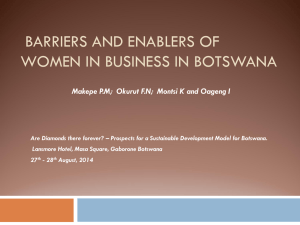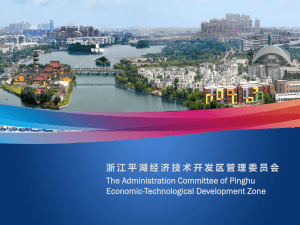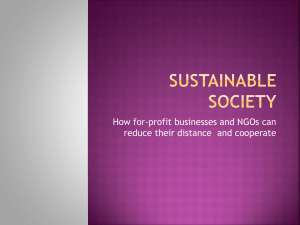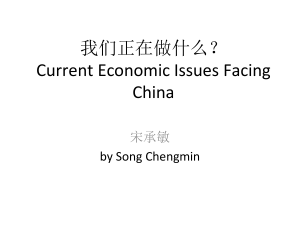2.3 Challenges from the macro
advertisement
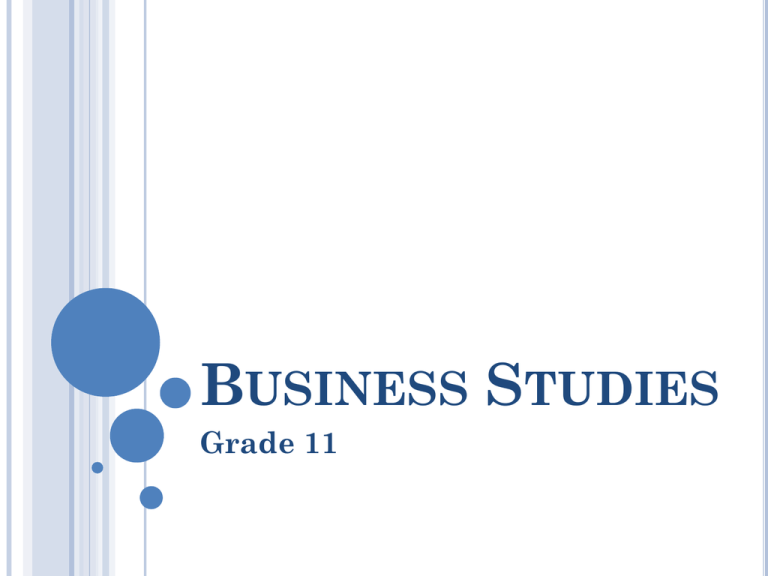
BUSINESS STUDIES Grade 11 TERM 1 Business Environments and Business Operations CHALLENGES IN THE BUSINESS ENVIRONMENT 2.1 CHALLENGES FROM THE MICRO ENVIRONMENT Difficult employees tend to complain a lot. influence new and positive employees in a negative way. are usually not passionate about their jobs. can harm an enterprise’s image if they say negative things about the enterprise. 2.1 CHALLENGES FROM THE MICRO ENVIRONMENT Lack of vision and mission A business enterprise’s mission and vision is supposed to direct business operations in a way that allows the business enterprise to become a market leader. A business enterprise without a mission will be aimless and without direction. Managers will not be capable of providing meaningful guidance and leadership to employees as management will not know where the enterprise is heading. 2.1 CHALLENGES FROM THE MICRO ENVIRONMENT Lack of adequate managerial skills leads to the business enterprise not achieving its objectives. subordinates are not inspired by managers who lack important managerial skills. managers lacking managerial skills will not be capable of managing their departments successfully. employees managed by managers with inadequate skills will be unhappy and frustrated – unhappy employees are usually not very productive. unhappy employees could cause a high employee turnover rate which reflects badly on the enterprise and complicates the recruitment process. 2.1 CHALLENGES FROM THE MICRO ENVIRONMENT Unions Aim to further the interests of employees who belong to the union. Sometimes, unions make demands that are impossible to meet. This creates tension between management and employees. 2.1 CHALLENGES FROM THE MICRO ENVIRONMENT Strikes and go-slows If management and employees are unable to settle their differences, employees sometimes resort to labour action (also known as strikes). A go-slow is an example of labour action. Employees show up at their place of work, but work so slowly that the business cannot meet its production targets. By the time management realizes what is happening, the enterprise has lost many hours of production. Skills shortages among employees Sometimes business enterprises have difficulty finding employees with the right combination of skills and experience. Businesses are then forced to employ candidates who are inadequately qualified. Employing unqualified candidates can result in: accidents in the workplace poor decision making overloading qualified employees High employee turnover High employee turnover means employees resign from their employers frequently and new employees constantly have to be recruited. A high employee turnover rate is a strong indication that a business enterprise is experiencing problems. The challenges from the micro-environment are under the direct control of the enterprise’s management. 2.2 CHALLENGES FROM THE MARKET ENVIRONMENT Competition Businesses offering the same of similar products often pose a serious threat to one another. Consumers will buy from the enterprise that offers the best value for money. This means that if an enterprise is unable to match the quality and prices of its competitors, it is in danger of losing consumers. 2.2 CHALLENGES FROM THE MARKET ENVIRONMENT Shortages of supply There can be a number of reasons why enterprises experience shortages of supply, e.g. a fuel crisis that complicates delivery or a supplier’s employees could go on strike. Nonetheless, an enterprise experiencing shortages of supply will lose consumers as the consumers will buy goods from other enterprises. 2.2 CHALLENGES FROM THE MARKET ENVIRONMENT Changes in consumer behavior Factors such as economic conditions or the financial position of an enterprise’s target market can cause changes in the target market’s tastes and habits. This will cause the target market to shrink, leaving the business with fewer people to market its products to. 2.2 CHALLENGES FROM THE MARKET ENVIRONMENT Demographics Changes in the population are one of the most significant factors that influence business enterprises. Demographic changes that are currently occurring in South Africa include: People tend to live longer. This leads to an increased demand for products. Many people immigrate or pursue job opportunities abroad. This not only leads to a reduced consumer base but also to reduced availability of skilled labour. Many South Africans are dying because of HIV/Aids. HIV doesn’t only influence the labour force and the consumer force, but HIV-positive consumers have particular product preferences. 2.2 CHALLENGES FROM THE MARKET ENVIRONMENT Psychographics Psychographics is also known as lifestyle segmentation and involves determining consumer characteristics such as consumers’ attitudes, interests, opinions and lifestyles. Businesses can market their products effectively only if they know the psychographics of their target market. It is difficult to determine the psychographics of a target market because it changes constantly. 2.2 CHALLENGES FROM THE MARKET ENVIRONMENT Socio-cultural factors Include factors such as language, ethnicity, customs, income levels and preferences associated with particular cultures. Socio-cultural factors influence enterprises’ product ranges and marketing campaigns. Extra care must be taken buy a business enterprise to ensure that the marketing campaign does not offend any cultural group. 2.3 CHALLENGES FROM THE MACRO-ENVIRONMENT Changes in income levels Factors such as unemployment, high interest rates and high inflation rates cause fluctuation in consumers’ income levels. This can leave consumers with less disposable income. Reduced consumer spending results in lower profits for enterprises. Consumers experiencing financial difficulties spend their money on necessities, rather than luxuries. Changes in consumers’ income levels can be a serious threat, especially for enterprises specializing in luxury goods and services. 2.3 CHALLENGES FROM THE MACRO-ENVIRONMENT Political changes Each government determines the objectives it wants to achieve while it is in office. Governments make laws to help them achieve these objectives. Businesses have to adapt to these laws. A change in government can result in political instability. Political instability scares off potential investors and potential tourists. 2.3 CHALLENGES FROM THE MACRO-ENVIRONMENT Contemporary legislation Failure to comply with legislation has serious consequences, such as harsh fines or prison sentences. It seems obvious that business enterprises do not have any option but to meet legal requirements, but this is not always easy. For example: The Employment Equity Act suggests that candidates who were previously disadvantaged should receive preference when an enterprise is recruiting new employees. This limits the number of candidates an enterprise can choose from and sometimes it is difficult to find candidates with the right combination of qualifications and experience. 2.3 CHALLENGES FROM THE MACRO-ENVIRONMENT Labour restrictions Research has shown that some business enterprises feel that South Africa’s labour market is overly regulated. Restrictions that occur in the labour force that pose potential challenges to businesses include: Shortage of skilled labour BBBEE Affirmative action 2.3 CHALLENGES FROM THE MACRO-ENVIRONMENT HIV / AIDS HIV/Aids challenges business operations in more ways than one. HIV/Aids reduces the number or candidates an enterprise can choose from and impacts negatively on the productivity of an enterprise. Some enterprises contribute towards an antiretroviral fund to assist HIV-positive employees. This places a financial burden on enterprises. 2.3 CHALLENGES FROM THE MACRO-ENVIRONMENT Micro-lending Micro-lending is the extension of small loans (micro-loans) to people who cannot gain access to credit granted by banks. There are two reasons why people make use of micro lending: Many people fail to meet the minimum credit requirements set by financial institutions, such as banks. Many people have obligations to meet, such as credit card payments, rental expenses, or they want to buy products they cannot afford. The micro lending business is not regulated. There is therefore very little protection for people who make use of the services of micro-lenders. The conditions set by micro-lenders are sometimes unreasonable. 2.3 CHALLENGES FROM THE MACRO-ENVIRONMENT Globalisation and international challenges Globalisation refers to the exchange of goods, services, capital and labour across borders. This means that local businesses compete with international businesses for local consumers. Globalisation has made it relatively easy to pursue career opportunities abroad, which can result in local skills shortages. In some countries, labour is very cheap. This can make it even more difficult for local business enterprises to be competitive in the global market. 2.3 CHALLENGES FROM THE MACRO-ENVIRONMENT Social values People’s values can influence their buying habits because consumers buy products they identify with. Social values that can impact on consumers’ buying habits include consumers’ attitudes towards saving and brand loyalty. Business enterprises cannot control consumers’ social values. 2.3 CHALLENGES FROM THE MACRO-ENVIRONMENT Demographics Some demographical challenges currently influencing South African business enterprises include: immigration illegal immigrants shrinkage of the labour force (due to crime, disease, immigration, poverty) Demographical changes can result in business enterprises having to train new employees and selecting potential employees from a smaller pool of candidates.



